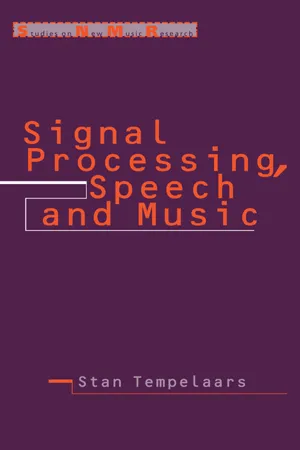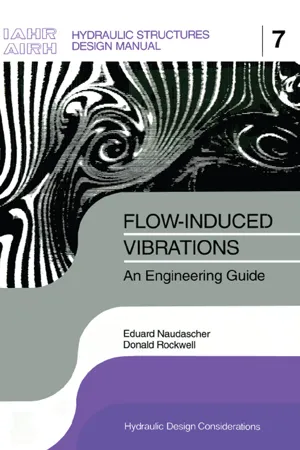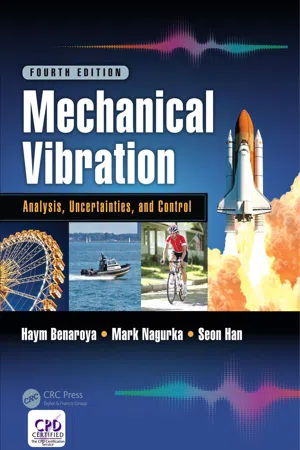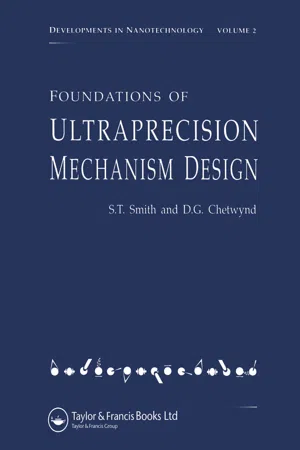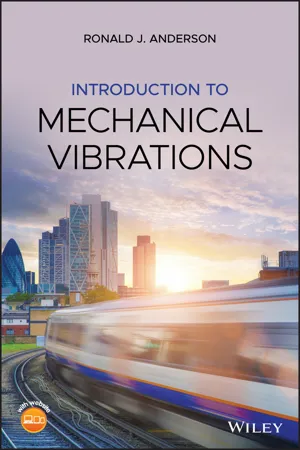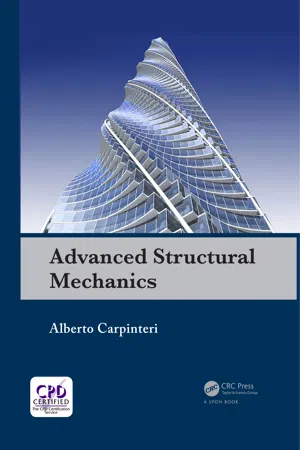Damped harmonic oscillator
A damped harmonic oscillator is a system that experiences a restoring force proportional to its displacement from equilibrium, as well as a damping force that reduces its velocity. This results in the oscillations of the system gradually decreasing in amplitude over time. The behavior of damped harmonic oscillators can be described using differential equations, and they are commonly encountered in physics and engineering.
8 Key excerpts on "Damped harmonic oscillator"
- eBook - ePub
- Stan Tempelaars(Author)
- 2014(Publication Date)
- Routledge(Publisher)
...C HAPTER 3 The Harmonic Oscillator 3.1 Undamped vibrations - the time-continuous case A. The vibrating string; equation and solution We shall now study a few versions of the simple system called ‘the harmonic oscillator’. First we will analyse the behaviour of a vibrating string via a simplified model, in which we place a metal ball in the middle of the string. See fig.3.1.1. Thanks to this ball we can ignore the mass of the string itself, which simplifies the calculation considerably. On the ball in both directions a force S is exercised by means of the tension of the string. We now assume now that during the vibration the displacement and therefore the changes in the length of the string are so small that we may consider S as a constant. We indicate the displacement of the ball with y (t). If the string at the place of the ball is pulled to the side the two forces S no longer lie in each others direction and a restoring force F occurs, which is shown in the diagram via the parallelogram construction and can be calculated as follows: If we combine this with Figure 3.1.1 Vibrating string. The factor 4 S/L is abbreviated to b. In this expression both the magnitude and the direction of force F are represented, the latter with the minus sign that shows that the force and the displacement are in opposite directions. We combine this result with Newton’s law: This is a differential equation of the second order, which can be considered as the mathematical model of the system (see also Morse 1948). For the determination of the solution we start with a ‘trial’ function...
- eBook - ePub
- William Bolton(Author)
- 2012(Publication Date)
- Routledge(Publisher)
...The system will oscillate at, what is termed, a natural frequency, such frequencies being determined by the properties of the system. 3 Forced oscillations Oscillations which take place under the effect of externally applied periodic forces are called forced oscillations. Thus if the support of the spring system in Figure 6.1(a) was itself oscillating it would give forced oscillations of the spring system. 4 Damping Oscillating mechanical systems are all subject to damping due to energy being dissipated by friction and other resistances. With free oscillations, since no energy is externally supplied to the system when oscillating then the effect of energy being dissipated by damping is for the oscillations to die away with time. Thus if the simple pendulum in Figure 6.1(c) is set into free oscillation, the oscillation will gradually die away with time with the amplitude of the oscillation becoming progressively smaller. 6.2 Simple harmonic motion The simplest form of periodic motion is simple harmonic motion. Consider a basic mechanical system of mass which when deflected from its rest position is restored to it by forces arising from elasticity in the system. Figure 5.3 shows such a system as a trolley tethered between two supports by springs. A trolley is considered for the mass in order to effectively eliminate frictional effects. Figure 6.3 A basic mechanical system When the trolley, the mass of the system, is pulled to one side then one of the springs is compressed and the other stretched and this has the effect of providing a restoring force which is directed in such a direction as to endeavour to restore the trolley back to its original position. If the trolley is released from this deflected position, the restoring force causes the trolley to move back towards its original rest position and overshoot that position. The restoring force then reverses its direction to still be directed towards the rest position and so oscillations occur...
- eBook - ePub
Flow-induced Vibrations: an Engineering Guide
IAHR Hydraulic Structures Design Manuals 7
- Eduard Naudascher(Author)
- 2017(Publication Date)
- Routledge(Publisher)
...Thus, the real part of this expression may be considered the horizontal projection and the imaginary part the vertical projection; and again, it is the former which represents the harmonic motion or vibration. In Figure 2. lb, T = 1/ f denotes the period of vibration. Figure 2.1. Definition sketch, (a) Simple undamped body oscillator, (b) Histogram of harmonic motion, (c) Vector respresenlation of harmonic motion. 2.2 FREE VIBRATION The simplest body oscillator consists of a discrete mass m free to vibrate in one direction (Figure 2.1a). In the absence of damping and exciting forces, an initial displacement x o will produce free vibrations as shown in Figure 2.1b. They can be analyzed with the aid of the equation of motion or the energy method. In the equation of motion, the product of mass m and body acceleration d 2 x /d t 2 ≡ ẍ (the dots denote derivatives with respect to time) is set equal to the sum of all forces m x ¨ = ∑ F x (2.3) which in case of a linear spring in the undamped system of Figure 2.1a is simply the restoring force, Σ F x = − Cx. The larger the spring constant C, the greater is the stiffness of the oscillator. The solution of the equation of motion m x ¨ + C x = 0 (2.4) is x = x o cos (ω n t − φ) (2.5) with ω n = 2 π f n = C / m (2.6) where ω n is the natural circular frequency and f n is the natural frequency of the discrete-mass system. For the particular initial condition cited above, the phase angle φ is zero. For systems of greater complexity, determination of the natural frequency from the equation of motion becomes so complicated that it is advisable to use an energy approach. Since the spring force Cx is the only external force doing work on the system, the sum of elastic and kinetic energy is constant. Consequently, the kinetic energy m ẋ 2 /2 in the middle of the stroke (x = 0, ẋ = ω x o) must be equal to the elastic energy in an extreme position (x = x o, ẋ = 0), i.e., ∫ o x o C x d x = 1 2 C x o 2 = 1 2 m ω 2 x o 2 (2.7) Figure 2.2...
- eBook - ePub
- James C. Anderson, Farzad Naeim(Authors)
- 2012(Publication Date)
- Wiley(Publisher)
...Chapter 4 Response to Harmonic Loading 4.1 Undamped Dynamic System An undamped dynamic system subjected to a harmonically varying load has an equation of motion of the form 4.1 where p 0 = the amplitude of the driving force p = the driving frequency of the harmonic load, which is generally not the same as the natural frequency, The general solution of this differential equation consists of two parts as given by the following: 4.2 where v h (t) = A sin t + B cos t = the homogeneous solution that gives the free-vibration response v p (t) = the particular solution that gives the behavior generated by the form of the dynamic loading The particular solution has the form v p (t) = D sin pt, where the constant D is determined from the requirement that the particular solution must satisfy the equation of motion. Taking the form of the particular solution and substituting into the equation of motion, we have which results in the following expression for the constant D : 4.3 where is the ratio of the applied load frequency to the natural frequency of the system. Substituting the value for D, we get the following general solution for velocity and displacement: 4.4 As before, the constants A and B depend on the initial conditions. In the case of a system starting from rest, the initial conditions are. Applying these conditions, the constants take the form Applying these constants to the general form of the solution results in 4.5 where the individual terms can be identified as follows: From Equation (4.5), it can be seen that, for lightly damped systems, the peak steady-state response occurs at a frequency ratio near unity when the exciting frequency of the applied load equals the natural frequency of the system. This condition is called resonance...
- eBook - ePub
Mechanical Vibration
Analysis, Uncertainties, and Control, Fourth Edition
- Haym Benaroya, Mark Nagurka, Seon Han(Authors)
- 2017(Publication Date)
- CRC Press(Publisher)
...The approximation 9 can be verified numerically and the angle beyond which the assumption breaks down can be identified. With this approximation, the equation of motion, Equation A.13, becomes (A. 15) d 2 θ d t 2 + θ = 0 which is an equation for a linear harmonic oscillator. Equation A.15 is valid only for small oscillations about the equilibrium position, θ = 0. To summarize, for small oscillations about the equilibrium, we set θ ≪ 1 and retain the first term in the Taylor series of the nonlinear function. This first term of the series is always linear. Some useful series about θ 0 = 0 are listed in Table A.1. The Taylor series centered at zero is also called a Maclaurin series. 10 Table A.1 Taylor Series Expansion about 0. A.4 Ordinary Differential Equations Any equation involving derivatives is called a diffe rential equation. If there is only one independent variable the equation is termed an ordinary diffe rential equation. If the dependent variable is a function of two or more parameters, for example time and spatial coordinate y (t, x), then the differential equation is called a partial differential equation. The study of vibration depends heavily on the solution of linear ordinary differential equations with time as the independent variable. A common form in vibration studies is a 2 ÿ (t) + a 1 y ˙ (t) + a 0 y (t) = f (A.16)subject to the initial conditions y (0) and y (0). The coefficients a 2, a 1, and a 0 are constants, 11 f (t) is a given function of time, and overdots denote differentiation with respect to time. If f (t) ≠ 0, the differential equation is called non ‐ homogeneous ; if f (t) = 0, the differential equation is called homogeneous. Equation A.16 is known as an initial ‐ value problem since its solution depends on the given initial values (or conditions) y (O) and y ˙ (0)...
- eBook - ePub
- Stuart T. Smith(Author)
- 2017(Publication Date)
- CRC Press(Publisher)
...Response to sudden changes of input and sensitivity to vibration are the main concerns. Resonance in individual elements and complete structures is of importance to both. A common experience of using instruments to the limits of precision is that of working through many long nights, because external disturbances from fellow workers and other machinery is lower then – perhaps an improved understanding of dynamics at this level can literally put us in the light. Resonance is everywhere in nature and so familiar that a general description is unnecessary. However, it is useful to review the simplest mechanical oscillator systems in order to confirm the physical assumptions that are made also in more complex analyses. To obtain simple, tractable models of the response of a system to a dynamically varying input, or demand, signal, we attempt to describe it by a set of linear equations. The simplest case is where the output is linearly proportional to the input for all values of demand. However, almost invariably energy (power) is to be transferred from one element to another and energy storage in the mechanisms will cause transmission delays. The system response can then only be adequately described by differential equations. For systems described by a set of linear differential equations, the amplitude of the system response to a steady state demand is linearly proportional to its frequency content and its associated delay, or phase lag. If the signal consists of a number of frequencies at the input, the principle of superposition applies and the amplitudes and phase lags of each frequency can be added either vectorially or trigonometrically. Alternatively if the amplitude, frequency and phase of an input is known, the amplitude and phase of the output can be predicted. The frequency remains unchanged if the system is linear. All mechanical elements have mass and elasticity...
- eBook - ePub
- Ronald J. Anderson(Author)
- 2020(Publication Date)
- Wiley(Publisher)
...The equation of motion is (5.11) We need to look at all possible forms for a harmonic forcing function keeping in mind that we will need to find the particular solution for Equation 5.11. Note that we need to add together a function and its first two derivatives on the left‐hand side and make the sum equal to a single function on the right‐hand side. This is clearly a case where the complex exponential function is the best choice 1. Therefore, let (5.12) Before proceeding any farther, it is advisable to write the equation of motion in the standard form. We therefore divide Equation 5.11 by and write (5.13) Figure 5.4 Damped SDOF system with a harmonically applied force. and assume that the steady state solution for is (5.14) with derivatives (5.15) and (5.16) Substituting into Equation 5.13 gives (5.17) from which we can solve directly for which, after a little rearranging of terms, becomes (5.18) Admittedly, in Equation 5.18 is a complex number, but that simply indicates that the response can be written as an amplitude and a phase angle. Before working out the amplitude and phase angle we will manipulate Equation 5.18 in order to make it dimensionless. We start by dividing the numerator and denominator by to get (5.19) Then we note that the term,, in the numerator is simply equal to so that the numerator becomes which is the static deflection that we found in Equation 5.7. We can then write (5.20) This is a good time for a short review of complex numbers. Any complex number, can be represented by a magnitude and a phase angle. If you plot as a point on the complex plane you will see that you can represent the same point in polar coordinates with a line of length that lies at an angle from the real axis where. The number can equally well be represented as a complex exponential using Euler's Identity. That is, we can write For what we are about to do, the exponential notation is preferable...
- eBook - ePub
- Alberto Carpinteri(Author)
- 2017(Publication Date)
- CRC Press(Publisher)
...5.59 becomes (5.61) x (t) = 1 2 ξ F k [ e - ξ ω t (ξ 1 - ξ 2 sin ω D T + cos ω D T) - cos ω t ] For a low amount of damping, it follows that ω = ω D and the denominator term is nearly equal to unity. In this case, the equation can be written in the approximate form: (5.62) x (t) = 1 2 ξ F k (e - ω t - 1) cos ω t For zero damping, this equation is indeterminate, but when L’Hôpital’s rule is applied, one obtains (5.63) x (t) = - 1 2 F k ω t cos ω t Equation 5.63 is plotted in Figure 5.8, describing the linear increase in the oscillation amplitude. The notions investigated in the present section, and particularly the graphic of Figure 5.7, are particularly useful in the (stiffness and damping) design of machine suspensions, of antiseismic building foundations, and, more generally, in all those cases where it is necessary to dynamically isolate a structural element from an adjacent vibrating element. The bodywork of a car must be isolated from wheel motion, as well as a building structure from ground motion. In contrast, the floor must be isolated from machine motion in the case of rotating machines. Figure 5.8 5.4 PERIODIC LOADING Let us consider a harmonic oscillator subjected to a periodic loading F (t) (Figure 5.9). It is convenient to express this function in a Fourier series: the response to each term of the series will be similar to that obtained for the harmonic loading. The global solution will be the sum of each partial response, by the use of the superposition principle. The periodic function F (t) can be expressed as (5.64) F (t) = a 0 + ∑ n = 1 ∞ a n cos 2 π n T F t + ∑ n = 1 ∞ b n sin 2 π n T F t where T F is the loading period and the harmonic amplitude coefficients can be evaluated using the. expressions: (5.65a) a 0 = 1 T F ∫ 0 T F F (t) d t (5.65b) a n = 2 T F ∫ 0 T F F (t) cos 2 π n T F t d t (5.65c) b n = 2 T F ∫ 0 T F F (t) sin 2 π n T F t d t By denoting the frequency of the loading F (t) with ω F = 2 π / T F, the...
